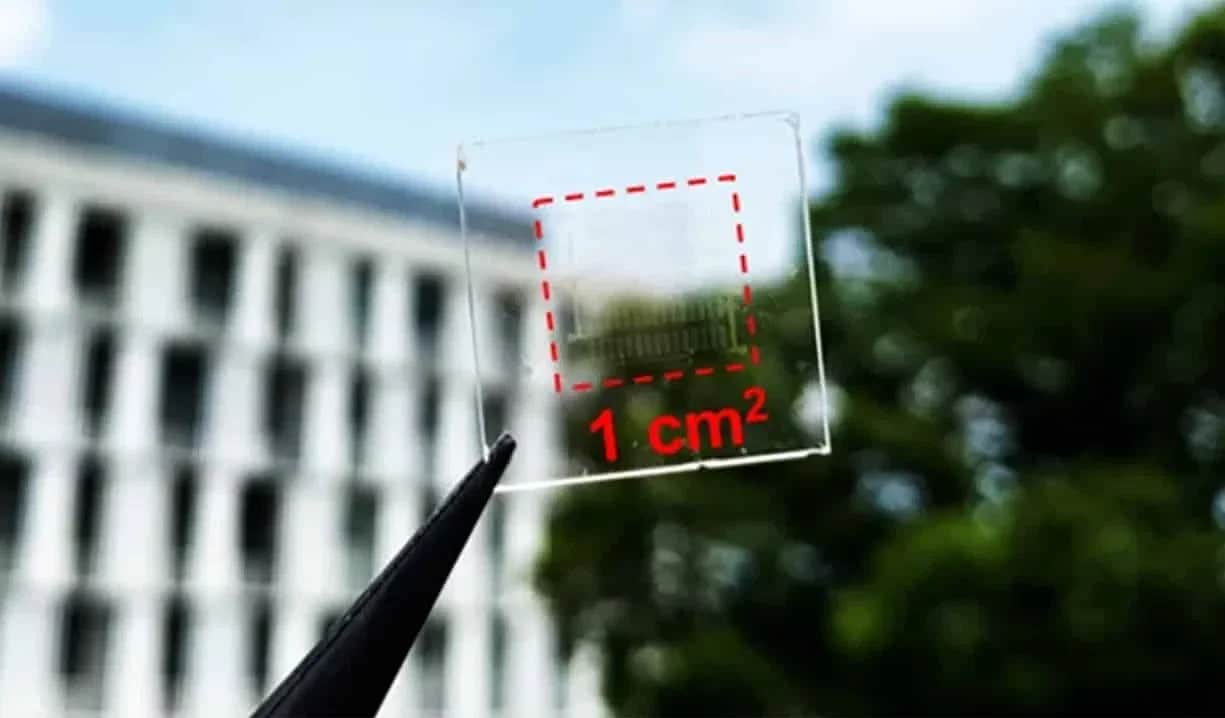The future of solar power is clear—literally
Traditional panels are bulky, stiff, and completely opaque. That makes them hard to fit into most urban designs or consumer products.

A visible-light photograph of an ultra-transparent solar cell constructed using a two-dimensional atomic layer. (CREDIT: Toshiaki Kato)
Solar power has earned its place as a clean energy alternative. But despite its promise, everyday use still falls short. Traditional solar panels are rigid, bulky, and block all light. That makes them tough to work into sleek city architecture or modern consumer devices.
Because of these design limits, solar panels usually end up on rooftops or out in open fields. That could soon change. A new kind of solar cell—nearly invisible—may soon bring power generation into places never thought possible. These transparent cells could turn windows, windscreens, or even skin into active energy sources.
Unlike their older cousins, these next-gen cells don’t shout for attention. They slip into their surroundings without disrupting design or function. Some versions are so clear they let through up to 79% of light. Many average over 70% transparency—enough to go unnoticed while still collecting energy.
Much of this breakthrough comes from a class of materials just a few atoms thick. These are known as two-dimensional, or 2D, materials. Among them, transition metal dichalcogenides stand out. They absorb light efficiently and come with adjustable band gaps, which makes them especially useful for solar innovation.
These features allow engineers to design solar panels that look almost invisible yet perform reliably. The old compromise between power output and visual appeal no longer applies. With this tech, performance doesn’t have to mean poor aesthetics.
Recent Developments in Material Technologies
To make these near-invisible cells, researchers combined tungsten disulfide with a transparent, flexible conductor. That conductor, indium tin oxide, is already found in phone screens and touch panels. It's strong, common, and well-tested in the electronics world.
By testing how these two materials interact, researchers found ways to boost sunlight absorption without dimming transparency. The result is a thin, bendable sheet that can turn everyday light into usable electricity—quietly and efficiently.
Related Stories
- Scientists create ultra-thin solar panels that are 1,000x more efficient
- Cutting-edge walkable solar panels could revolutionize clean energy
- Cutting-edge new technology safely recycles 99% of used solar panels
The team, led by Toshiaki Kato at Tohoku University, optimized the contact barriers between these materials by coating ITO with thin layers of copper and tungsten oxide. This architectural adjustment reduced the Schottky barrier height, enhancing carrier collection and energy conversion efficiency.
“Our approach improved the power conversion efficiency over 1,000 times compared to devices using standard ITO electrodes,” explained Kato. The resulting device achieved an AVT of 79% and a power density of 13 milliwatts per square centimeter, comparable to the performance of opaque solar cells.
Scaling the technology presented additional challenges. As device size increased, an unexpected drop in open-circuit voltage was observed. Researchers addressed this by refining the aspect ratio of the unit devices, ensuring consistent performance across larger areas.
These advancements culminated in the development of a 1 cm² solar cell that generated 420 picowatts with minimal impact on transparency.
Applications: A Solar Renaissance
The potential applications for NISCs are vast. In architecture, they could transform windows into energy-generating panels without altering aesthetics or reducing natural light.
This innovation could enable skyscrapers, with their expansive glass surfaces, to become power plants. For electric vehicles, transparent solar cells could be integrated into windshields or body panels, enhancing range and reducing reliance on charging infrastructure.
Wearable technology also stands to benefit. These cells could power smartwatches, fitness trackers, or medical devices embedded in clothing or accessories. Future iterations might even integrate into human skin to power biomedical implants like pacemakers or glucose monitors.
Smart devices represent another promising avenue. Transparent solar cells could replace traditional glass components in smartphones and tablets, enabling self-charging gadgets that eliminate the need for external power sources.
Environmental Impact
The shift toward transparent solar cells holds profound environmental implications. By embedding solar technology into everyday objects, the reliance on fossil fuels can diminish significantly.
Unlike traditional energy sources, solar power produces no greenhouse gas emissions, aligning with global efforts to combat climate change. Additionally, these cells contribute to a circular economy by expanding the utility of previously underutilized surfaces.
Despite their promise, transparent solar cells face hurdles before widespread adoption. Durability remains a concern, particularly as devices must withstand prolonged exposure to environmental conditions. Manufacturing scalability is another challenge, as precise material deposition techniques are required for consistent performance.
Material costs also play a role. TMDs and other advanced materials used in NISCs are relatively expensive compared to silicon, the primary material in traditional solar panels. Researchers are actively exploring cost-effective alternatives and manufacturing innovations to make this technology accessible to a broader market.
A Vision for the Future
The journey toward fully transparent solar cells illustrates the power of interdisciplinary collaboration. Advances in nanotechnology, materials science, and engineering have converged to produce devices that defy conventional limitations. As these technologies mature, they are poised to redefine how solar energy is perceived and utilized.
“The potential of transparent solar cells extends far beyond current applications,” said Kato. “From powering urban infrastructure to integrating with consumer electronics, these cells symbolize a sustainable future that harmonizes technology with the environment.”
The findings of this research, published in Scientific Reports, signal a paradigm shift in renewable energy technology. With continued innovation, near-invisible solar cells could become the cornerstone of a greener, more connected world.
Note: Materials provided above by The Brighter Side of News. Content may be edited for style and length.
Like these kind of feel good stories? Get The Brighter Side of News' newsletter.



